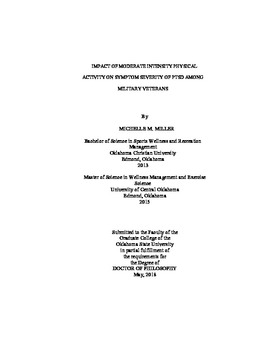| dc.contributor.advisor | Zahl, Melissa | |
| dc.contributor.author | Miller, Michelle Marie | |
| dc.date.accessioned | 2019-03-22T18:57:11Z | |
| dc.date.available | 2019-03-22T18:57:11Z | |
| dc.date.issued | 2018-05 | |
| dc.identifier.uri | https://hdl.handle.net/11244/317664 | |
| dc.description.abstract | The rates of PTSD among military veterans are much greater when compared to the general population, and are higher in the U.S. than any other country. Due to the known benefits of physical activity on mental and physical health, it may be beneficial for recreational therapists to use physical activity as an alternative treatment for treating symptoms of PTSD among military veterans. Physical activity has been found to be a critical component to a biopsychosocial approach in recovery-oriented mental health services, which parallels the recreational therapist's goal of treating the four behavioral domains of a person, the cognitive, psycho/social, physical, and affective. The purpose of this study was to determine if a combination Health Belief Model and physical activity intervention could improve symptom severity of PTSD among military veterans when compared to a Health Belief Model only group. Nine participants were randomly divided into an experimental group and a control group. The dependent variables were symptoms severity of PTSD, measured using the PCL-5, barriers to accessing healthcare, measured using the BACE, and cardiovascular health, measured using the Cooper 12 Minute Walk Test. A 2X2 RM ANOVA was utilized to analyze results as well as Cohen's d for effect size calculations. There were no significant group effects for any dependent variables. There were significant time * group interactions for the following dependent variables, BACE total score, and BACE Stigma score (p < .05), and there were significant time effects for all dependent variables (p < .05). Effect sizes for all dependent variables in the experimental group were all large and greater than the control group effect sizes, with the exclusion of the PCL-5 Cluster E variable. Effect sizes for the control group ranged from small to large. Utilizing physical activity may provide the recreational therapist a viable, effective, efficient, and cost-effective method of treating symptom severity of PTSD among military veterans. | |
| dc.format | application/pdf | |
| dc.language | en_US | |
| dc.rights | Copyright is held by the author who has granted the Oklahoma State University Library the non-exclusive right to share this material in its institutional repository. Contact Digital Library Services at lib-dls@okstate.edu or 405-744-9161 for the permission policy on the use, reproduction or distribution of this material. | |
| dc.title | Impact of moderate intensity physical activity on symptom severity of PTSD among military veterans | |
| dc.contributor.committeeMember | Passmore, Tim | |
| dc.contributor.committeeMember | Price, Taryn | |
| dc.contributor.committeeMember | DeFreitas, Jason | |
| dc.contributor.committeeMember | Mwavita, Mwarumba | |
| osu.filename | Miller_okstate_0664D_15591.pdf | |
| osu.accesstype | Open Access | |
| dc.type.genre | Dissertation | |
| dc.type.material | Text | |
| thesis.degree.discipline | Health, Leisure and Human Performance | |
| thesis.degree.grantor | Oklahoma State University | |
